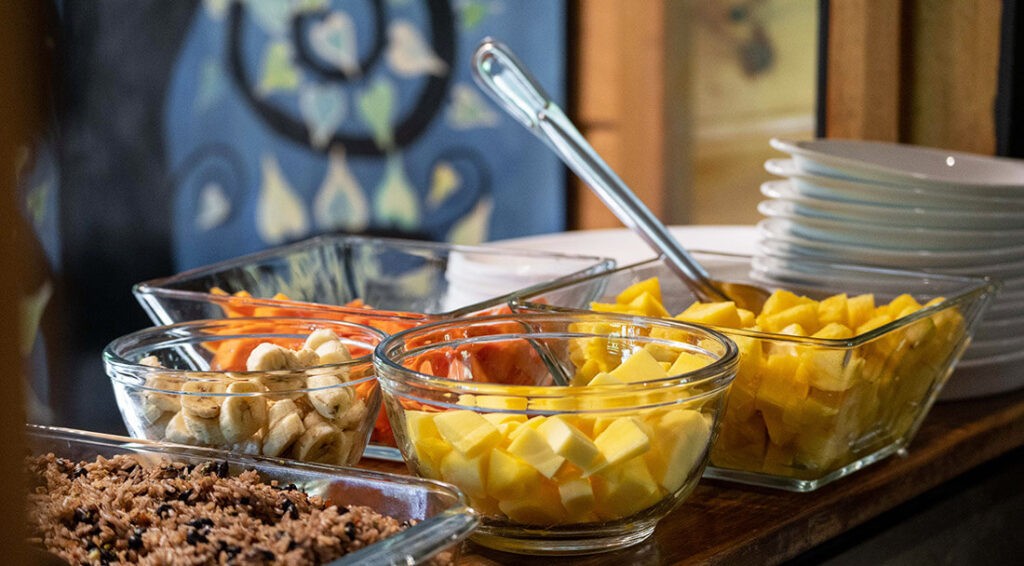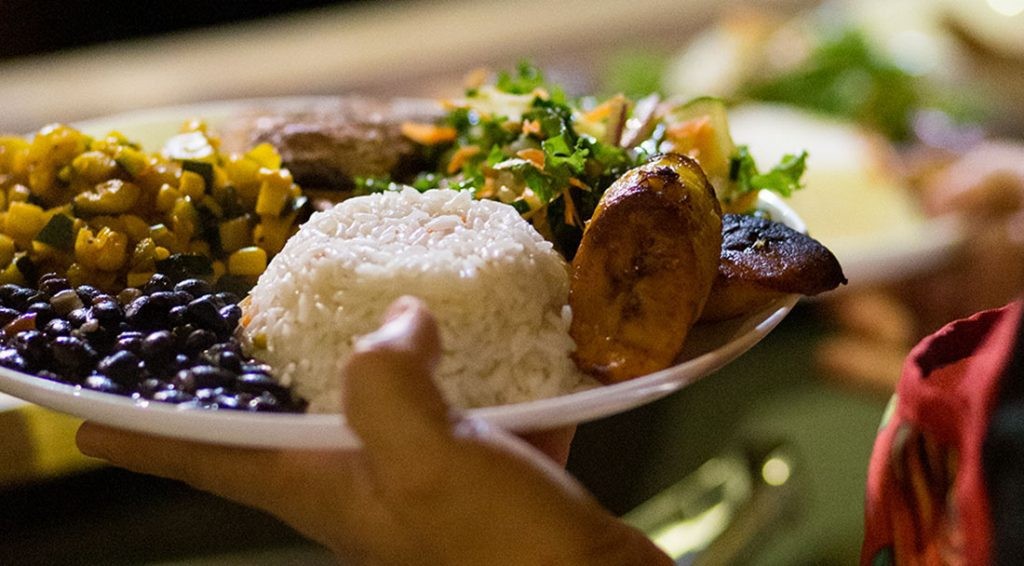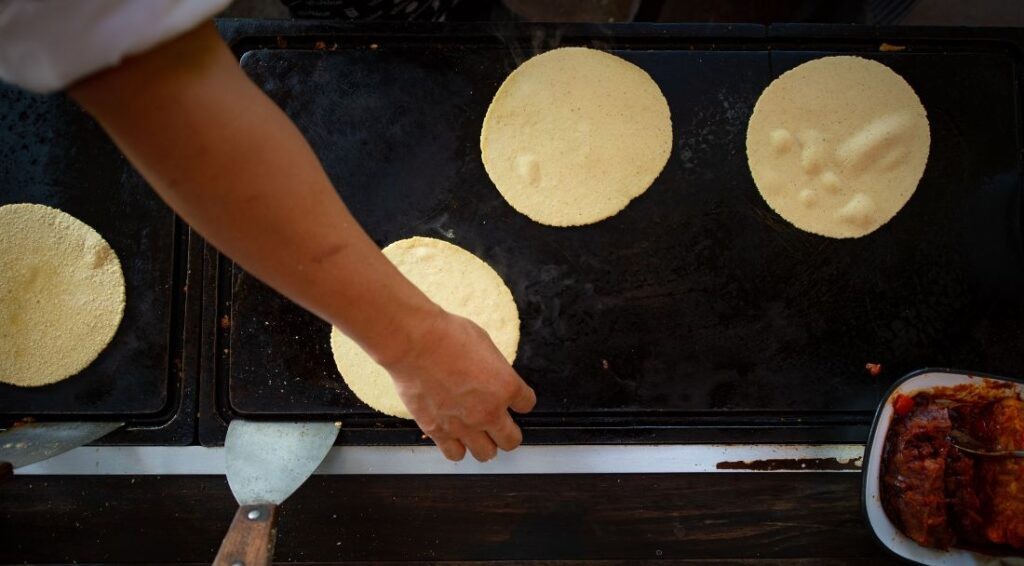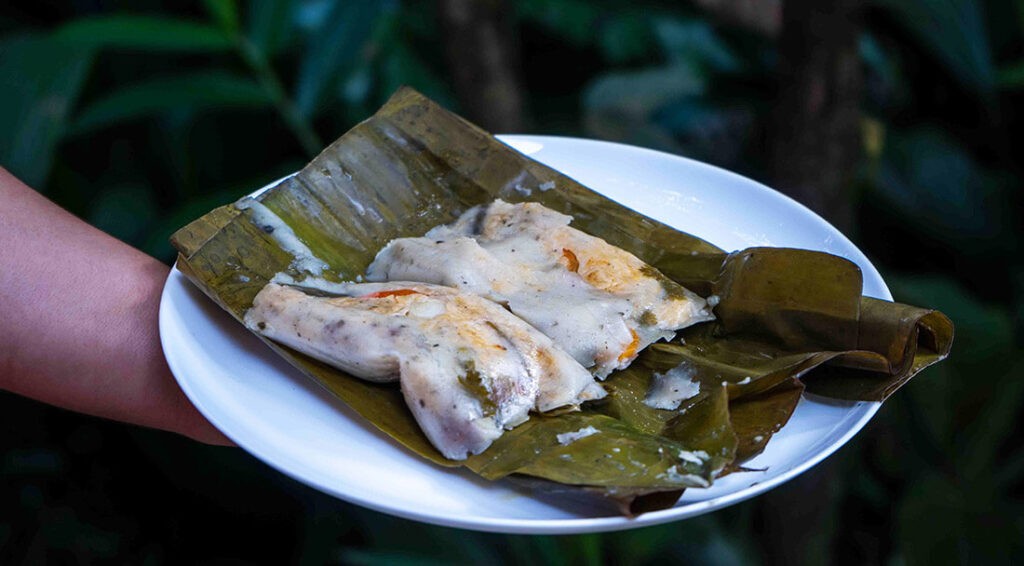Costa Rican food offers a vibrant exploration of flavors and traditions, offering a delightful culinary experience. Discover Costa Rican cuisine with FOODS.EDU.VN, your guide to deliciousness. Ready to delve into the heart of Costa Rica through its food? Get ready to discover some tasty food insights.
1. Costa Rican Food: A Tapestry of Flavors
Costa Rican cuisine is more than just sustenance; it’s a cultural expression, a fusion of indigenous traditions, Spanish influences, and African flavors. Imagine a symphony of tastes, where the earthiness of black beans dances with the sweetness of ripe plantains, all under the vibrant zest of fresh lime. This is the essence of comida típica, or traditional Costa Rican food. The country’s rich volcanic soil and tropical climate provide an abundance of fresh ingredients, making it a true foodie paradise. So let’s explore this rich culinary history.
1.1 Key Ingredients in Costa Rican Cuisine
The foundation of many Costa Rican dishes lies in a few key ingredients: rice, beans, plantains, and corn. These staples are often combined with fresh vegetables, fruits, and various meats or seafood. Here’s a quick look at some essential components:
- Rice and Beans: These are the cornerstone of the Costa Rican diet, often eaten at every meal.
- Plantains: This versatile fruit can be enjoyed in sweet and savory dishes, from crispy patacones to caramelized maduros.
- Corn: Used to make tortillas, chorreadas, and other traditional dishes.
- Fresh Fruits: Mangoes, pineapples, papayas, and passion fruit are just a few of the many delicious fruits that thrive in Costa Rica.
- Vegetables: Root vegetables like cassava and taro, along with tomatoes, onions, peppers, and chayote squash, are commonly used.
- Seafood: With coastlines on both the Pacific Ocean and the Caribbean Sea, Costa Rica has access to a wide variety of fresh seafood.
- Salsa Lizano: This unique sauce, with its slightly sweet and tangy flavor, is a staple in Costa Rican cuisine.
1.2 Geographical Influences and Regional Variations
Costa Rica’s diverse geography plays a significant role in shaping its culinary landscape. The country is divided into several distinct regions, each with its own unique flavors and culinary traditions:
| Region | Typical Dishes & Ingredients |
|---|---|
| Central Valley | Olla de Carne (beef stew), Picadillo de Arracache (arracache hash), fresh dairy products, coffee. |
| Caribbean Coast | Rice and beans cooked in coconut milk, Rondon (seafood stew), Patí (spiced meat pie), spicy sauces. |
| Pacific Coast | Fresh seafood dishes like ceviche and grilled fish, Arroz con Camarones (rice with shrimp), Patacones served with various toppings. |
| Guanacaste | Gallo Pinto (rice and beans), corn-based dishes like tortillas and Tamales, beef dishes influenced by cowboy culture. |





1.3 Historical and Cultural Significance of Costa Rican Food
The history of Costa Rican food is a fascinating story of cultural exchange and adaptation. Indigenous tribes, such as the Chorotega and Huetar, relied on corn, beans, and squash as their primary food sources. When the Spanish arrived in the 16th century, they introduced new ingredients and cooking techniques, including rice, wheat, and livestock.
Over time, these influences merged to create the unique culinary identity of Costa Rica. Dishes like Gallo Pinto and Olla de Carne reflect the blending of indigenous and Spanish traditions. The arrival of African slaves also brought new flavors and ingredients to the Caribbean coast, resulting in dishes like rice and beans cooked in coconut milk. It’s all part of a rich, deep culinary history.
2. Experiencing Authentic Costa Rican Food
To truly appreciate Costa Rican food, you must experience it firsthand. Whether you’re visiting a local soda (small family-run restaurant) or trying your hand at recreating traditional recipes at home, there are countless ways to immerse yourself in the flavors of Costa Rica.
2.1 Must-Try Costa Rican Dishes
No culinary journey through Costa Rica is complete without sampling some of the country’s most iconic dishes. Here are a few must-try items:
- Gallo Pinto: The quintessential Costa Rican breakfast, consisting of rice and beans cooked with onions, peppers, cilantro, and Salsa Lizano. Served with eggs, cheese, and plantains.
- Casado: A hearty lunch or dinner plate with rice, beans, plantains, salad, tortillas, and your choice of meat, fish, or chicken.
- Olla de Carne: A traditional beef stew with potatoes, carrots, chayote squash, and other root vegetables.
- Ceviche: Fresh raw fish marinated in lime juice, cilantro, onions, and peppers. A refreshing and flavorful dish, perfect for a hot day.
- Patacones: Twice-fried plantain slices, crispy on the outside and soft on the inside. Served with guacamole, refried beans, or Salsa Lizano.
- Tamales: Corn dough pockets filled with seasoned meat, vegetables, or cheese, wrapped in banana leaves, and steamed. A Christmas tradition in Costa Rica.
- Arroz con Pollo: Rice cooked with chicken, vegetables, and spices. A comforting and flavorful dish.
2.2 Exploring Local Sodas and Markets
One of the best ways to experience authentic Costa Rican food is to visit local sodas. These small, family-run restaurants offer home-style cooking at affordable prices. You’ll find classic dishes like Gallo Pinto, Casado, and Olla de Carne on the menu, all made with fresh, local ingredients.
Another great way to immerse yourself in Costa Rican culture is to visit local markets. Here, you can find a wide variety of fresh fruits, vegetables, spices, and other ingredients. Chat with the vendors, sample local products, and learn about the culinary traditions of the region. This provides a truly immersive experience.
2.3 Cooking Costa Rican Food at Home
While traveling to Costa Rica is the best way to experience the cuisine firsthand, you can also recreate traditional dishes at home. There are countless recipes available online and in cookbooks, allowing you to bring the flavors of Costa Rica to your own kitchen.
FOODS.EDU.VN offers a wealth of recipes and cooking tips, making it easy to prepare authentic Costa Rican meals. Check out our website for step-by-step instructions, ingredient lists, and helpful videos.
3. Costa Rican Breakfast Delights
Breakfast in Costa Rica is a hearty and satisfying affair, designed to provide energy for the day ahead. Gallo Pinto is the undisputed star of the breakfast table, but there are plenty of other delicious options to explore.
3.1 The Quintessential Gallo Pinto
Gallo Pinto, meaning “spotted rooster,” is the national dish of Costa Rica. This simple yet flavorful dish consists of rice and beans cooked together with onions, peppers, cilantro, and Salsa Lizano. The key to a great Gallo Pinto is using day-old rice, which helps to create a slightly crispy texture.
Gallo Pinto is typically served with eggs (scrambled, fried, or poached), cheese, plantains, and tortillas. Some people also add sour cream or avocado. Each family has their own unique version of Gallo Pinto, so be sure to try it at different sodas to find your favorite.
3.2 Variations on a Theme: Regional Twists
While Gallo Pinto is the standard breakfast fare throughout Costa Rica, there are regional variations to be found. On the Caribbean coast, Gallo Pinto is often cooked with coconut milk, giving it a sweeter and more fragrant flavor. In Guanacaste, it may be served with grilled beef or chorizo.
Other popular breakfast items include chorreadas (corn pancakes), tostadas (toasts with various toppings), and tortillas served with cheese, beans, or eggs.
3.3 Sweet Treats: Chorreadas and More
For those with a sweet tooth, chorreadas are a must-try breakfast item. These corn pancakes are made with fresh ground corn, milk, and sugar. They are cooked on a griddle until golden brown and slightly crispy.
Chorreadas can be served with butter, honey, syrup, or sour cream. They are a delicious and satisfying way to start the day. Another popular sweet treat is plátanos maduros (ripe plantains) caramelized in butter and sugar.
4. Lunchtime in Costa Rica: Casados and Beyond
Lunch in Costa Rica is typically a hearty and filling meal, designed to provide energy for the afternoon. Casado is the most popular lunchtime dish, but there are also plenty of other delicious options to explore.
4.1 The Iconic Casado: A Plateful of Flavors
Casado, meaning “married man,” is a traditional Costa Rican lunch plate that includes a variety of different components. The basic Casado consists of rice, beans, plantains, salad, tortillas, and your choice of meat, fish, or chicken.
The meat or fish is usually grilled, fried, or stewed. The salad typically includes lettuce, tomato, cucumber, and cabbage. The plantains can be either maduros (sweet) or patacones (savory). Each element contributes to a balanced and satisfying meal.
4.2 Regional Variations and Unique Combinations
Like Gallo Pinto, Casado has regional variations. On the Caribbean coast, it may include rice and beans cooked in coconut milk, along with Caribbean-style chicken or fish. In Guanacaste, it may be served with grilled beef or pork.
Other popular lunchtime dishes include arroz con pollo (rice with chicken), ceviche (raw fish marinated in lime juice), and empanadas (savory pastries filled with meat, cheese, or vegetables).
4.3 Midday Snacks: Empanadas and Tamales
For a lighter lunch or a midday snack, empanadas and tamales are excellent choices. Empanadas are savory pastries filled with meat, cheese, or vegetables. They can be baked or fried.
Tamales are corn dough pockets filled with seasoned meat, vegetables, or cheese, wrapped in banana leaves, and steamed. They are a popular dish during Christmas, but can be enjoyed year-round.
5. Dinner Delights: From Arroz con Pollo to Seafood Feasts
Dinner in Costa Rica is a time to relax and enjoy the flavors of the day. From comforting rice dishes to fresh seafood feasts, there’s something for everyone to enjoy.
5.1 Arroz con Pollo: A Comforting Classic
Arroz con Pollo (rice with chicken) is a classic Costa Rican dish that’s perfect for a comforting dinner. The rice is cooked with chicken, vegetables, and spices, creating a flavorful and satisfying meal.
Arroz con Pollo is often served with french fries and a side salad. It’s a popular dish for both locals and tourists. This is a universally loved meal.
5.2 Seafood Extravaganza: Fresh Catches and Creative Preparations
With coastlines on both the Pacific Ocean and the Caribbean Sea, Costa Rica has access to a wide variety of fresh seafood. From grilled fish to shrimp cocktails, there are countless ways to enjoy the bounty of the sea.
Popular seafood dishes include ceviche (raw fish marinated in lime juice), arroz con camarones (rice with shrimp), and pescado entero frito (whole fried fish).
5.3 Meat Lovers’ Paradise: Chicharrones and More
For meat lovers, chicharrones (fried pork rinds) are a must-try. These crispy and flavorful snacks are often served as an appetizer or side dish.
Other popular meat dishes include carne en salsa (beef in sauce), cerdo asado (roasted pork), and bistec encebollado (steak with onions).
6. Costa Rican Snacks and Street Food
Exploring the street food scene in Costa Rica is a must for any food lover. From savory empanadas to sweet treats like tres leches cake, there’s something to satisfy every craving. These culinary gems offer an authentic taste of local culture.
6.1 Savory Bites: Empanadas, Tacos, and More
Savor the explosion of flavors in Costa Rica’s savory street food. Empanadas, with their crispy crusts and diverse fillings, are a crowd favorite. Tacos, often filled with seasoned meats, fresh vegetables, and zesty sauces, provide a quick and satisfying bite.
| Savory Street Food | Description |
|---|---|
| Empanadas | Savory pastries filled with meat, cheese, or vegetables. They can be baked or fried, offering a delightful snack. |
| Tacos | Corn or wheat tortillas filled with seasoned meats, fresh vegetables, and zesty sauces. A quick and satisfying bite, perfect for a meal on the go. |
| Chifrijo | A popular dish consisting of rice, beans, chicharrones (fried pork rinds), tortilla chips, avocado slices, and pico de gallo. A hearty and flavorful combination, often enjoyed as a snack or appetizer. |
6.2 Sweet Temptations: Tres Leches and Churros
Indulge in the sweet side of Costa Rican street food with treats like tres leches cake and churros. Tres leches, a sponge cake soaked in three kinds of milk, is a decadent dessert that melts in your mouth. Churros, fried dough pastries dusted with sugar and cinnamon, offer a warm and comforting sweetness.
6.3 Unique Finds: Churchills and Copos
Discover the unique and refreshing street food items in Costa Rica. Churchills, shaved ice desserts layered with ice cream, condensed milk, and various toppings, are a local favorite. Copos, similar to snow cones, offer a simple yet satisfying way to cool down on a hot day.
7. Drinks of Costa Rica: Coffee, Agua Dulce, and More
No culinary journey is complete without exploring the local beverages. Costa Rica offers a variety of drinks, from world-renowned coffee to refreshing fruit juices.
7.1 The Coffee Culture: From Bean to Cup
Costa Rica is famous for its high-quality coffee. Coffee beans are grown in the country’s fertile volcanic soil and harvested by hand. Coffee is a way of life in Costa Rica.
7.2 Refreshing Beverages: Agua Dulce and Natural Juices
Agua Dulce, meaning “sweet water,” is a traditional Costa Rican beverage made from hot water and sugar cane. It’s a simple yet refreshing drink that’s often enjoyed with breakfast. A delicious and refreshing drink to try.
7.3 Alcoholic Drinks: Imperial Beer and Guaro
Imperial is the most popular beer in Costa Rica. It’s a light and refreshing lager that’s perfect for a hot day.
Guaro is a clear, sugarcane-based liquor that’s often mixed with fruit juice or soda. It’s the national liquor of Costa Rica.
8. Vegetarian and Vegan Options in Costa Rican Cuisine
Costa Rica offers a variety of vegetarian and vegan options, thanks to its abundance of fresh fruits, vegetables, and legumes. Explore the diverse plant-based cuisine that the country has to offer.
8.1 Gallo Pinto and Casado: Vegan Adaptations
Gallo Pinto and Casado can easily be adapted to vegan diets by omitting the meat, cheese, and eggs. Instead, focus on the flavorful rice, beans, plantains, and salad.
You can also add vegetables to your meal. Ask for picadillo (vegetable hash), which is a mix of potatoes, carrots, chayote squash, and other vegetables.
8.2 Plant-Based Staples: Beans, Rice, and Plantains
Beans, rice, and plantains are staples in Costa Rican cuisine, making them excellent options for vegetarians and vegans. These ingredients can be prepared in a variety of ways, offering endless possibilities for delicious and satisfying meals. There are plenty of plant based options available.
8.3 Creative Dishes: Hearts of Palm Ceviche and More
Explore creative vegetarian and vegan dishes like hearts of palm ceviche, which offers a refreshing and flavorful alternative to traditional fish ceviche. This innovative dish highlights the versatility of plant-based ingredients.
9. Desserts and Sweet Treats in Costa Rica
End your culinary journey on a sweet note with Costa Rica’s delectable desserts and sweet treats. From creamy rice pudding to decadent cakes, there’s something to satisfy every sweet tooth.
9.1 Arroz con Leche: Creamy Rice Pudding
Arroz con Leche (rice with milk) is a creamy and comforting rice pudding that’s popular throughout Latin America. In Costa Rica, it’s typically made with rice, milk, sugar, cinnamon, and raisins.
Arroz con Leche is often served warm or cold. It’s a classic dessert that’s perfect for any occasion. It’s a tasty and well known dish.
9.2 Tres Leches: A Milk-Soaked Delight
Tres Leches (three milks) is a light and airy sponge cake that’s soaked in three different kinds of milk: evaporated milk, condensed milk, and heavy cream. The cake is then topped with whipped cream and cinnamon.
Tres Leches is a decadent dessert that’s perfect for celebrations. It’s a popular choice for birthdays and holidays.
9.3 Traditional sweets
Costa Rica offers a variety of traditional sweets. Try cajetas (milk caramels) and cocadas (coconut sweets). These are enjoyed by locals and tourists alike.
10. Food Festivals and Culinary Events in Costa Rica
Immerse yourself in Costa Rican culture by attending food festivals and culinary events. These events offer a unique opportunity to sample local cuisine, learn about traditional cooking techniques, and celebrate the country’s rich culinary heritage.
10.1 National Festivals: Celebrating Culinary Traditions
Attend national festivals like the Día del Boyero (Oxcart Driver’s Day) and the Fiestas de Palmares. These festivals showcase the country’s culinary traditions, featuring food stalls, cooking demonstrations, and cultural performances.
10.2 Local Markets: A Food Lover’s Paradise
Explore local markets like the Mercado Central in San José and the Mercado de Liberia. These bustling markets offer a wide variety of fresh produce, local specialties, and street food. These are perfect for any foodie.
10.3 Cooking Classes and Workshops
Join cooking classes and workshops to learn how to prepare traditional Costa Rican dishes. These hands-on experiences provide valuable insights into the country’s culinary techniques and ingredients.
11. Sourcing Ingredients: Local Markets and Sustainable Practices
Discover the best places to source ingredients in Costa Rica and learn about sustainable practices that support local communities.
11.1 Visiting Local Markets
Explore local markets like the Mercado Central in San José and the Mercado de Liberia. These markets offer a wide variety of fresh produce, local specialties, and unique ingredients.
11.2 Supporting Local Farmers
Support local farmers by purchasing their produce at farmers’ markets and roadside stands. This helps to support local communities and promotes sustainable agriculture.
11.3 Sustainable Seafood Practices
Choose seafood that’s sustainably harvested. Look for certifications from organizations like the Marine Stewardship Council (MSC) and the Aquaculture Stewardship Council (ASC).
12. Tips for Dining Out in Costa Rica
Make the most of your dining experiences in Costa Rica with these helpful tips.
12.1 Ordering Food
When ordering food, be prepared to use Spanish. While many restaurants have English menus, knowing some basic Spanish phrases can be helpful. Be polite when ordering food.
12.2 Tipping Culture
Tipping is not always expected in Costa Rica. Some restaurants include a 10% service charge in the bill. If there is no service charge, it is customary to leave a 10% tip.
12.3 Restaurant Etiquette
Costa Ricans are generally very friendly and welcoming. Be polite and respectful to your servers. Take your time and enjoy your meal. Dining is considered a social occasion.
13. Food and Health: Nutrition and Dietary Considerations
Understand the nutritional aspects of Costa Rican cuisine. Consider dietary restrictions and health concerns.
13.1 Nutritional Value
Costa Rican cuisine is rich in nutrients. Traditional dishes use fresh produce and whole grains.
13.2 Dietary Restrictions
Costa Rica caters to various dietary needs. Many restaurants offer gluten-free and vegetarian options. Communicate your needs clearly when ordering.
13.3 Health Concerns
Be aware of potential health concerns, such as foodborne illnesses. Choose reputable establishments.
14. Preserving Costa Rican Food Culture
Learn about the efforts to preserve and promote Costa Rican food culture.
14.1 Supporting Local Cuisine
Support local cuisine. Choose dishes made with local ingredients. Preserve the country’s culinary heritage.
14.2 Culinary Education
Engage in culinary education. Learn about traditional cooking techniques. Preserve the country’s rich culinary heritage.
14.3 Food Tourism
Participate in food tourism. Explore Costa Rica’s culinary landscape. Support local businesses and communities.
15. Costa Rican Food: Beyond the Plate
Costa Rican food is more than just what’s on your plate; it’s an integral part of the country’s culture, history, and social fabric. Each dish tells a story, reflecting the unique blend of indigenous traditions, Spanish influences, and African flavors that have shaped the country’s culinary identity. By exploring the world of Costa Rican food, you can gain a deeper understanding of this vibrant and welcoming nation.
15.1 The Role of Food in Social Gatherings
In Costa Rica, food plays a central role in social gatherings. Whether it’s a family meal, a community celebration, or a casual get-together with friends, food is always at the heart of the event. Sharing a meal is a way to connect with others, strengthen bonds, and celebrate life.
Traditional dishes like tamales and olla de carne are often prepared for special occasions, symbolizing unity and togetherness. These communal meals are a testament to the importance of Food In Costa Rican society.
15.2 Food as a Symbol of National Identity
Costa Rican cuisine is also a symbol of national identity. Dishes like Gallo Pinto and Casado are considered national treasures, representing the country’s culinary heritage and cultural pride.
These iconic dishes are not only delicious but also reflect the values and traditions of Costa Rican society. They are a reminder of the country’s rich history, its commitment to sustainability, and its dedication to preserving its cultural heritage.
15.3 Food and the Environment: Sustainability and Eco-Tourism
Costa Rica is known for its commitment to sustainability and eco-tourism, and this ethos extends to its food culture as well. Many restaurants and businesses prioritize the use of local, organic ingredients, supporting local farmers and promoting sustainable agriculture.
Visitors to Costa Rica can participate in eco-tourism activities. Learn about sustainable food production. Support local communities. This helps to preserve the country’s natural resources for future generations.
16. Modern Trends in Costa Rican Food
Discover the latest culinary trends. Explore innovative approaches. Costa Rican cuisine continues to evolve.
16.1 Fusion Cuisine
Experience fusion cuisine. Costa Rican chefs combine traditional ingredients with international flavors. Offers creative dining experiences.
16.2 Farm-to-Table Dining
Engage in farm-to-table dining. Restaurants use local produce. The restaurants support sustainable agriculture.
16.3 Gourmet Costa Rican Cuisine
Explore gourmet Costa Rican cuisine. Chefs experiment with local ingredients. Highlighting the country’s culinary potential.
17. How to Plan a Culinary Trip to Costa Rica
Planning a culinary trip to Costa Rica requires careful consideration of your interests, budget, and travel style. Whether you’re a seasoned foodie or a casual traveler, there are plenty of ways to immerse yourself in the country’s vibrant food scene.
17.1 Researching Destinations and Culinary Experiences
Before you start planning your trip, take some time to research the different regions of Costa Rica. Each region has its own unique culinary traditions and specialties.
17.2 Choosing Accommodations with Culinary Offerings
When choosing accommodations, consider options. These places may offer cooking classes, or access to local markets.
17.3 Creating a Food Itinerary
Create a food itinerary. Include visits to local markets, and restaurants. Sample street food, and participate in cooking classes.
18. Essential Spanish Phrases for Food Lovers
Learning a few basic Spanish phrases can greatly enhance your culinary experiences in Costa Rica. Locals will appreciate your efforts to communicate in their language. It will provide more authentic interactions.
18.1 Basic Greetings and Politeness
Start with basic greetings and phrases of politeness.
18.2 Ordering Food and Drinks
Learn phrases. Order food and drinks. Specify your preferences. Communicate any dietary restrictions.
18.3 Describing Food and Flavors
Expand your vocabulary. Describe food and flavors. Understand local ingredients. Express your opinions.
19. Budget-Friendly Eating in Costa Rica
Enjoy delicious Costa Rican cuisine without breaking the bank.
19.1 Eating at Sodas
Dine at sodas. These family-run restaurants offer affordable meals. Provide an authentic culinary experience.
19.2 Shopping at Local Markets
Shop at local markets. Purchase fresh produce. Prepare your own meals. This saves money.
19.3 Cooking Your Own Meals
Prepare your own meals. Use local ingredients. Explore Costa Rican cuisine.
20. Responsible and Sustainable Food Practices in Costa Rica
Support responsible and sustainable food practices during your visit to Costa Rica.
20.1 Supporting Local Businesses
Support local businesses. Choose restaurants use local ingredients. This helps to sustain local communities.
20.2 Reducing Food Waste
Reduce food waste. Order only what you can eat. Take leftovers with you. Support restaurants minimize waste.
20.3 Choosing Eco-Friendly Options
Choose eco-friendly options. Support sustainable agriculture. Protect the environment.
Discover the best of Costa Rican food with FOODS.EDU.VN.
FAQs
- What is the national dish of Costa Rica?
The national dish of Costa Rica is Gallo Pinto, a flavorful combination of rice and beans. - What is Casado?
Casado is a traditional Costa Rican lunch plate consisting of rice, beans, plantains, salad, tortillas, and your choice of meat, fish, or chicken. - What are some popular vegetarian dishes in Costa Rica?
Popular vegetarian dishes include Gallo Pinto (without eggs or cheese), Casado (with extra vegetables), and Patacones (fried plantains). - What is Salsa Lizano?
Salsa Lizano is a unique Costa Rican sauce with a slightly sweet and tangy flavor. It’s a staple in Costa Rican cuisine. - What are Patacones?
Patacones are twice-fried plantain slices. These are crispy on the outside and soft on the inside. - What is Agua Dulce?
Agua Dulce is a traditional Costa Rican beverage made from hot water and sugar cane. - What is Imperial beer?
Imperial is the most popular beer in Costa Rica, a light and refreshing lager perfect for a hot day. - What are some traditional Costa Rican desserts?
Traditional desserts include Arroz con Leche (rice pudding), Tres Leches (milk-soaked cake), and Empanadas de Chiverre (squash-filled pastries). - What is ceviche?
Ceviche is a dish of fresh raw fish marinated in lime juice, cilantro, onions, and peppers. - How much should I tip in Costa Rica?
Tipping is not always expected in Costa Rica. If there is no service charge, it is customary to leave a 10% tip.
Ready to explore the culinary delights of Costa Rica? FOODS.EDU.VN offers a wealth of information, recipes, and travel tips. This is your passport to an unforgettable food adventure.
We hope you’ve found this guide informative and inspiring. Join us at FOODS.EDU.VN to discover even more about Costa Rican food. Learn about its vibrant culture. Check out our contact information for FOODS.EDU.VN: 1946 Campus Dr, Hyde Park, NY 12538, United States. For questions, message us on Whatsapp: +1 845-452-9600 or visit our website foods.edu.vn. Let’s continue this delicious adventure together.